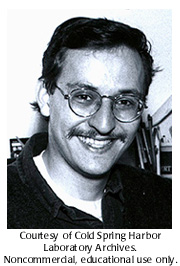Concept 38 Development balances cell growth and death.



 Lee Hartwell was one of the first to use yeast as a model system, and he identified many of the genes involved in the cell cycle. Bob Horvitz and Mike Hengartner used C. elegans to work out the mechanism of programmed cell death. Scott Lowe's research has shown how the regulation of the cell cycle affect cancer.
Lee Hartwell was one of the first to use yeast as a model system, and he identified many of the genes involved in the cell cycle. Bob Horvitz and Mike Hengartner used C. elegans to work out the mechanism of programmed cell death. Scott Lowe's research has shown how the regulation of the cell cycle affect cancer.
Michael Otmar Hengartner (1966-)

Mike Hengartner was born in St. Gallin, Switzerland. His father was a professor of mathematics and moved his family from Switzerland to Paris, France, then Bloomington, Indiana before finally settling in Montreal, Canada. This globe-trotting at a young age gave Hengartner a facility for language. He speaks English, French and German.
Hengartner never had any doubts about being a scientist. His main problem was deciding which branch of science to focus on. Mathematics was out of the question because his older brother went into math. Hengartner initially thought of going into physics, but then read a book called What is Life? by Erwin Schrodinger. Hengartner realized that most physicists were switching fields and becoming biologists. Hengartner decided, therefore, not to waste time with physics. He graduated with a B.S. in biochemistry from Laval University in Quebec in 1988.
Hengartner was accepted into the Massachusetts Institute of Technology's biology department for graduate school. He was eager to work with Nobel Laureate David Baltimore on viral proteins. However, before making the final decision, Hengartner was persuaded by a friend to attend a lab meeting where he met Bob Horvitz who ran a Caenorhabiditis elegans lab. At the time, the C. elegans field was still rather new and Hengartner didn't really like the idea of working with worms. Yet, when Horvitz approached Hengartner to ask if he wanted to work in his lab, Hengartner was too "much of a coward" to say no. It did work out for the best because in a subsequent discussion about possible projects in the lab, Hengartner became fascinated with the idea of programmed cell death, and being able to determine the mechanism using C. elegans.
In 1994, Hengartner finished his doctorate in Horvitz's lab by cloning and characterizing ced-9, a gene necessary for programmed cell death in C. elegans.
Hengartner's work in Horvitz's lab led him to other genes involved in cell death both in C. elegans and in other organisms. After his Ph.D., Hengartner became a Staff Investigator at Cold Spring Harbor Laboratory (CSHL), where he was an Associate Professor of the Watson School of Biological Sciences at CSHL. He continued his research in a laboratory used by Barbara McClintock. In 2001, Hengartner moved to the University of Zurich, where he is Dean of the Faculty of Science and holds a chair in molecular biology.
He is an Executive Officer of the Cell Death Society and a co-founder of two biotech companies: Devgen, based in Belgium, and ForScience, which was based in New York. He is also on the editorial board of a number of science journals including Current Biology and Annals of Improbable Research. Hengartner has numerous patents based on his work.
Hengartner spends most of his leisure time with his family. He plays volleyball and won the haiku portion of the 2000 CSHL Blackford Coffee Poetry Contest (Blackford is CSHL's cafeteria) with this submission:
Black oozy syrup
Brew'd daily by the gallons
Free but at what price?


The cells that don't undergo programmed cell death in C. elegans often share the same cell fate as their sisters. The extra cells don't seem to have any detrimental effects.

The "extra" cells in C. elegans mutants that don't undergo programmed cell death are often nerve cells. Are these worms smarter?
 DNA is packaged in a chromosome.
DNA is packaged in a chromosome. Higher cells incorporate an ancient chromosome.
Higher cells incorporate an ancient chromosome. Some DNA does not encode protein.
Some DNA does not encode protein. Some DNA can jump.
Some DNA can jump. Genes can be turned on and off.
Genes can be turned on and off. Genes can be moved between species.
Genes can be moved between species. DNA responds to signals from outside the cell.
DNA responds to signals from outside the cell. Different genes are active in different kinds of cells.
Different genes are active in different kinds of cells. Master genes control basic body plans.
Master genes control basic body plans. Development balances cell growth and death.
Development balances cell growth and death. A genome is an entire set of genes.
A genome is an entire set of genes. Living things share common genes.
Living things share common genes. DNA is only the beginning for understanding the human genome.
DNA is only the beginning for understanding the human genome.